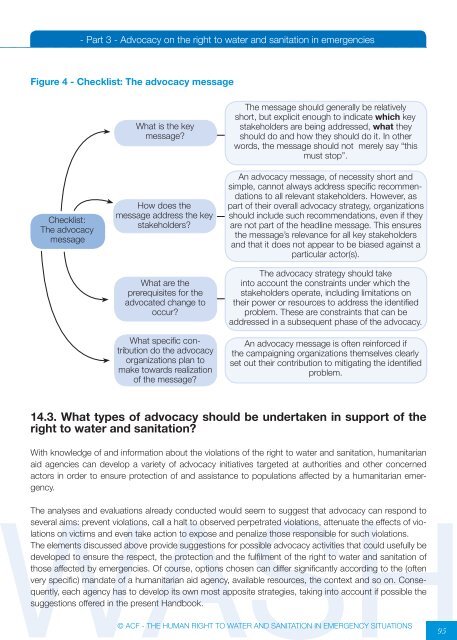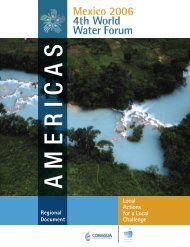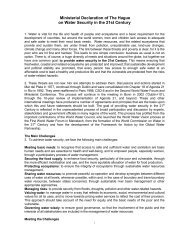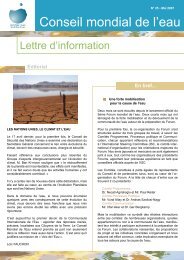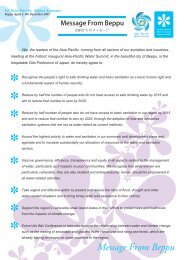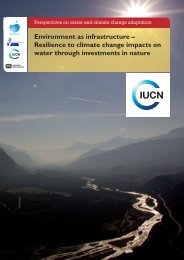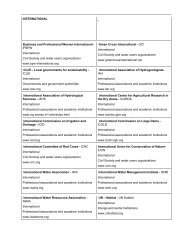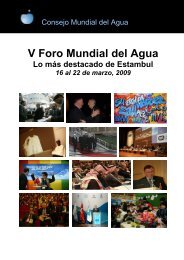the human right to water and sanitation in emergency situations
the human right to water and sanitation in emergency situations
the human right to water and sanitation in emergency situations
You also want an ePaper? Increase the reach of your titles
YUMPU automatically turns print PDFs into web optimized ePapers that Google loves.
- Part 3 - Advocacy on <strong>the</strong> <strong>right</strong> <strong>to</strong> <strong>water</strong> <strong>and</strong> <strong>sanitation</strong> <strong>in</strong> emergencies<br />
Figure 4 - Checklist: The advocacy message<br />
Checklist:<br />
The advocacy<br />
message<br />
What is <strong>the</strong> key<br />
message?<br />
How does <strong>the</strong><br />
message address <strong>the</strong> key<br />
stakeholders?<br />
What are <strong>the</strong><br />
prerequisites for <strong>the</strong><br />
advocated change <strong>to</strong><br />
occur?<br />
What specific contribution<br />
do <strong>the</strong> advocacy<br />
organizations plan <strong>to</strong><br />
make <strong>to</strong>wards realization<br />
of <strong>the</strong> message?<br />
The message should generally be relatively<br />
short, but explicit enough <strong>to</strong> <strong>in</strong>dicate which key<br />
stakeholders are be<strong>in</strong>g addressed, what <strong>the</strong>y<br />
should do <strong>and</strong> how <strong>the</strong>y should do it. In o<strong>the</strong>r<br />
words, <strong>the</strong> message should not merely say “this<br />
must s<strong>to</strong>p”.<br />
An advocacy message, of necessity short <strong>and</strong><br />
simple, cannot always address specific recommendations<br />
<strong>to</strong> all relevant stakeholders. However, as<br />
part of <strong>the</strong>ir overall advocacy strategy, organizations<br />
should <strong>in</strong>clude such recommendations, even if <strong>the</strong>y<br />
are not part of <strong>the</strong> headl<strong>in</strong>e message. This ensures<br />
<strong>the</strong> message’s relevance for all key stakeholders<br />
<strong>and</strong> that it does not appear <strong>to</strong> be biased aga<strong>in</strong>st a<br />
particular ac<strong>to</strong>r(s).<br />
The advocacy strategy should take<br />
<strong>in</strong><strong>to</strong> account <strong>the</strong> constra<strong>in</strong>ts under which <strong>the</strong><br />
stakeholders operate, <strong>in</strong>clud<strong>in</strong>g limitations on<br />
<strong>the</strong>ir power or resources <strong>to</strong> address <strong>the</strong> identified<br />
problem. These are constra<strong>in</strong>ts that can be<br />
addressed <strong>in</strong> a subsequent phase of <strong>the</strong> advocacy.<br />
An advocacy message is often re<strong>in</strong>forced if<br />
<strong>the</strong> campaign<strong>in</strong>g organizations <strong>the</strong>mselves clearly<br />
set out <strong>the</strong>ir contribution <strong>to</strong> mitigat<strong>in</strong>g <strong>the</strong> identified<br />
problem.<br />
14.3. What types of advocacy should be undertaken <strong>in</strong> support of <strong>the</strong><br />
<strong>right</strong> <strong>to</strong> <strong>water</strong> <strong>and</strong> <strong>sanitation</strong>?<br />
With knowledge of <strong>and</strong> <strong>in</strong>formation about <strong>the</strong> violations of <strong>the</strong> <strong>right</strong> <strong>to</strong> <strong>water</strong> <strong>and</strong> <strong>sanitation</strong>, <strong>human</strong>itarian<br />
aid agencies can develop a variety of advocacy <strong>in</strong>itiatives targeted at authorities <strong>and</strong> o<strong>the</strong>r concerned<br />
ac<strong>to</strong>rs <strong>in</strong> order <strong>to</strong> ensure protection of <strong>and</strong> assistance <strong>to</strong> populations affected by a <strong>human</strong>itarian <strong>emergency</strong>.<br />
The analyses <strong>and</strong> evaluations already conducted would seem <strong>to</strong> suggest that advocacy can respond <strong>to</strong><br />
several aims: prevent violations, call a halt <strong>to</strong> observed perpetrated violations, attenuate <strong>the</strong> effects of violations<br />
on victims <strong>and</strong> even take action <strong>to</strong> expose <strong>and</strong> penalize those responsible for such violations.<br />
The elements discussed above provide suggestions for possible advocacy activities that could usefully be<br />
developed <strong>to</strong> ensure <strong>the</strong> respect, <strong>the</strong> protection <strong>and</strong> <strong>the</strong> fulfilment of <strong>the</strong> <strong>right</strong> <strong>to</strong> <strong>water</strong> <strong>and</strong> <strong>sanitation</strong> of<br />
those affected by emergencies. Of course, options chosen can differ significantly accord<strong>in</strong>g <strong>to</strong> <strong>the</strong> (often<br />
very specific) m<strong>and</strong>ate of a <strong>human</strong>itarian aid agency, available resources, <strong>the</strong> context <strong>and</strong> so on. Consequently,<br />
each agency has <strong>to</strong> develop its own most apposite strategies, tak<strong>in</strong>g <strong>in</strong><strong>to</strong> account if possible <strong>the</strong><br />
suggestions offered <strong>in</strong> <strong>the</strong> present H<strong>and</strong>book.<br />
© ACF - THE HUMAN RIGHT TO WATER AND SANITATION IN EMERGENCY SITUATIONS<br />
95


